University of Louisiana at Lafayette
The University of Louisiana at Lafayette (UL Lafayette, University of Louisiana, or UL) is a public research university in Lafayette, Louisiana. It has the largest enrollment within the nine-campus University of Louisiana System and has the second largest enrollment in Louisiana.
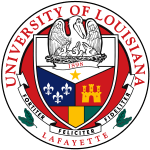 | |
| Motto | Fortiter, Feliciter, Fideliter |
|---|---|
Motto in English | Boldly, Happily, Faithfully |
| Type | Public |
| Established | July 14, 1898[1] |
| Endowment | $153.2 million[2] |
| President | E. Joseph Savoie |
Academic staff | 776 |
| Students | 16,934[3] |
| Undergraduates | 14,604[3] |
| Postgraduates | 2,330[3] |
| Location | , , United States |
| Campus | Urban
|
| Colors | Vermilion and White[4] |
| Athletics | NCAA Division I FBS Sun Belt |
| Nickname | Ragin' Cajuns |
| Affiliations | UL System APLU SURA |
| Website | www |
 | |
Founded in 1898 as an industrial school, the institution developed into a four-year university during the twentieth century and became known by its present name in 1999. It offers Louisiana's only Ph.D. in francophone studies, Louisiana's only master's of informatics, and Louisiana's only industrial design degree. The university has achieved several milestones in computer science, engineering and architecture. It is also home to a distinct College of the Arts.
History
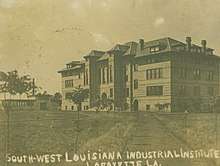
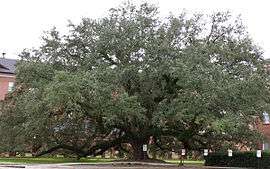
Timeline
- 1898 – State legislation passed allowing for creation of Southwestern Louisiana Industrial Institute (SLII).[5]
- 1899 – Board of trustees established and donation of 25 acres of land by Girard family.
- 1900 – Construction began and Dr. Edwin Stephens named president.
- 1901 – SLII opened September 18 with 100 students and eight faculty members.
- 1903 – 18 students were the first to graduate from SLII in two separate ceremonies.[6]
- 1920 – Began a four-year course culminating with a bachelor of arts degree.
- 1921 – SLII was changed into the Southwestern Louisiana Institute of Liberal and Technical Learning (SLI).[7]
- 1960 – SLI became the University of Southwestern Louisiana (USL).
- 1974 — The College of Sciences was officially formed.
- 1984 – Following approval from the Board of Trustees for State Colleges and Universities (now UL System), USL officially changed its name to the University of Louisiana, which was overturned less than a month later by an act of the state legislature, although two schools had previously changed their names using the same technique without outside interference.[8][9][10]
- 1997 – University's privately held assets reach almost $75 million.[11]
- 1999 – USL was renamed the University of Louisiana at Lafayette (UL Lafayette).[12][13]
Campus
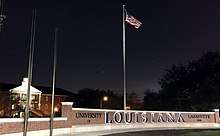
The campus of the University of Louisiana at Lafayette is located in Lafayette, Louisiana, a small city (CSA population of approx 620,000[14]) located in the south-central part of the state, the heartland of Cajun culture. The major roads that border or intersect the main UL campus are Johnston St, University Ave, Taft St and Lewis St. In addition, St. Mary St. bisects the campus and Girard Park Dr. creates another border at its eastern end.
A hallmark of the Main Campus is the numerous mature live oak trees dotted throughout the campus. Of special note is the "Century Oaks," so called as they were planted in the first years of the 20th century by the school's first president, Edwin Stephens. These trees are located along University Ave. In addition to the Main Campus, expansion has included two other areas located in the near vicinity: "University Commons," which contains the school's athletic complex, Greek housing, etc., as well as its "Research Park."
List of school properties/acreage
|
Main Campus
The historic Main Campus area originally consisted of only 25 acres, and its boundaries were Johnston Street, University Avenue, what is now Hebrard Blvd and to approximately Lee Hall in the Quad. By the 1930s the campus had more than doubled in size, to 60 acres, reaching to the newly constructed St Mary Street to its south, and McKinley Street to its east. This area includes such buildings/areas as: Martin Hall (Admin building), Girard Hall, Stephens Memorial, the Arcade, the Quadrangle (the Quad), Rose Garden dormitories, Judice-Rickles Halls, and Cypress Lake. Also, the two oldest extant buildings on campus are located in this area: Foster Hall (1902) and DeClouet Hall (1905).
The Quadrangle
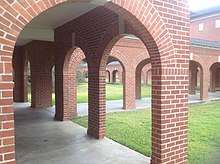
The Quadrangle (Quad,) which was completely renovated in 2015 (providing new walkways, landscaping and a fountain containing a 15-foot Fleur de Lis in its center), serves as the ‘heart’ of the university. It is surrounded by Martin Hall/FG Mouton Hall, as well as Moody, OK Allen, Lee, Broussard, Stephens, Mouton, M. Doucet, and Foster Halls. Some of the highlights of the Quad are:
- Martin Hall: originally called “the Main Building” was the first building constructed on campus, and was completed in 1901. Now sometimes referred to as “Old" Martin Hall, it stood on campus until 1963, when it was demolished and replaced with the current “New" Martin Hall. It is where the university president and administrative staff for the university are located.
- The Arcade: a covered, brick walkway that both surrounds and defines the quad. Built in 1940, and consisting of 415 brick arches, the Arcade is an iconic and beloved feature of the campus. It also is where the “Walk of Honor” begins.
- Walk of Honor: this feature honors every one of the undergraduates of the university, from 1903 through 2016, with a paver engraved with their name and year of graduation. Originally contained in the Arcade only, it now extends to the sidewalks within the Quad, continuing outside the Quad along Boucher Ave, and then turning onto McKinley. Future plans are that it will eventually turn onto St. Mary, heading towards Boucher St.
- The Fountain:located in the center of the Quad is a circular fountain, with an aluminum, 15’ three-sided Fleur de Lis sculpture as its centerpiece. Designed by over 100 UL students[15] over a five year period, the sculpture weighs over 3,000 pounds. Surrounded by benches it provides a popular gathering spot for students. Once the landscaping has fully matured, it is hoped that this will further give an oasis type feeling to the area.
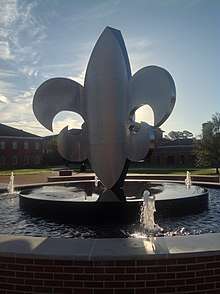 Fleur-di-lis fountain in UL Quad
Fleur-di-lis fountain in UL Quad
The Rose Garden Dormitory Complex
Located on the campus block bordered by Hebrard Blvd, University Ave and McKinley St, the original Rose Garden was surrounded Baker-Huger, Randolph, Evangeline, and Bonin Halls, which were all female only dormitories and designed by A. Hays Town and completed in 1950. In 2011 Baker-Huger, Evangeline and Bonin Halls were all demolished and were replaced with expanded/state of the art co-ed dormitories, now known as the Rose Garden complex.
Cypress Lake/Student Union Complex
- Cypress Lake/Cypress Lake Plaza: one of the most unique and beloved features on the campus, Cypress Lake is a university landmark that is also a habitat for native irises, alligators, turtles, birds and fish, as well as a hangout for students and a point of interest for tourists visiting Lafayette, Louisiana. Cypress Lake is casually called "The Swamp," which is also the nickname of the Louisiana Ragin' Cajuns football stadium, officially named Cajun Field. This ecosystem, located in the center of a university, it the only one of its kind in the United States. Many school traditions are held on/around the lake, especially during “Lagniappe Day.” Cypress Lake Plaza is a green space that was constructed in 2018-2019, following the removal of the former student union complex located along Hebrard Blvd. The new Plaza allows for more interaction between the students/faculty/alumni/public and Cypress Lake.[16]
- Student Union Complex: at 128K sq feet and completed in 2015 the new “U” was built to wrap around Cypress Lake, and includes numerous meeting spaces for students, as well several dining options (including the main dining room located on the second floor with floor to ceiling windows offering sweeping views of the lake), SGA offices, a post office, banquet space and a movie theater (the “Bayou Bijou.”)[17][18]
Expansion 1950-1980
The decades of the 1950–70s saw tremendous growth, both in the city of Lafayette as well as the university. During that period the main campus again expanded: to the east (Taft St), west (Rex St), and south (Lewis St) bringing the total amount of acreage for the main campus to approx. 125 acres. Many new academic buildings were located in this area including Dupre Library, HL Griffin Hall (Liberal Arts), Billeaud Hall (Biology), Madison Hall (Engineering), Wharton (Nursing), Angelle (Music), Fletcher (Art/Architecture), etc.
In 2012, and as part of the selling of its “Horse Farm” property to the city of Lafayette, the university acquired an additional 20 acres along the Johnston/Lewis St corridor when the Youth Park/Dog Park was added to the main campus. As of fall 2018, this area is being developed as housing for upperclassmen, and is called the “Heritage at Cajun Village.” With the addition of these 20 acres, the total acreage for the main campus is now at 145 acres.
Law enforcement services on the campus are provided by the University of Louisiana at Lafayette Police Department.
Future Expansion Plans
St Landry Corridor
Due to the fact that available, viable/undeveloped land adjacent to the main campus is very scarce, and while still facing an increasing student population, the university has been forced to find other properties to accommodate expansion. As such, the university is presently exploring options to possibly purchasing the property that Our Lady of Lourdes hospital (OLOL) was formerly located on. Ideally located between the Main Campus and University Commons locations, and bordered by St. Mary, St. Landry and St. Julian streets, the property consists of roughly 125 acres, and is now largely undeveloped. The only remaining buildings left from the OLOL complex are two parking towers, two medical office buildings, the old St. Joseph Orphanage, and several other minor structures.
Although included in the school's recent comprehensive Master Plan project,[19] no discernible public action has taken place as of late 2018, and the property remains on the market. Complicating matters for the purchase of the property include funding, as well as the fact that several buildings remaining on the property are actually owned by the Catholic Diocese of Lafayette, and were in turned being leased to OLOL.
University Commons
Starting with the purchase of the Whittington Farm property in 1936, the university added ~175 acres just south of the main campus, along Johnston St. This area, now also consisting of the Athletic Complex and Research Park areas form a total contiguous area of over 391 acres, known today as “University Commons.”[20]
Athletic Complex
Due to the continuing growth of the university during the 1950–70s, all of the main athletic facilities were relocated from the main campus to the University Commons area, which is bounded roughly by Reinhardt Dr, Bertrand St, Congress St and State St. The following is a list of major buildings in the complex[21]:
- Bourgeois Hall (the “Rec Center”)[22]
- Cajun Courts/Cullota Center (tennis complex)
- Cajundome/Convention Center (men’s & women's basketball)
- Cajun Field (home of the football team)
- Yvette Girouard Field at Lamson Park (softball complex)
- M. L. Tigue Moore Field at Russo Park (baseball complex)
- Track & Field Complex
Intramural Fields Complex
Located along Coliseum Road, the complex consists of a newly constructed Field House, as well as ~20 lighted acres of grassy fields, and convenient parking. This space enables the university the ability to offer numerous sports/activities to the student population.[23]
Research Park
Bounded by Cajundome Blvd, E. Landry Rd, and Congress St, the Research Park was conceived and developed to be a stimulant innovation and economic development that serves the region, state, and nation.[24] The following is a list of major buildings located in the park:
- University Research Park Hotel: Owned by the university, the hotel is a Hilton Garden Inn property. The 155-room hotel includes both classroom and faculty office accommodations and is collaboratively run with the UL Hospitality Management Program.
- Lafayette Primary Care Center: LPCC is a joint effort among Lafayette General Medical Center, Our Lady of Lourdes Regional Medical Center, LSU Medical Center, University Hospital & Clinics, and the UL. The facility is owned by the University, was paid for by Lafayette General Medical Center and Our Lady of Lourdes Regional Medical Center. It is operated by Lafayette General Medical Center and its mission is to train medical residents in family practice.
- CGI Group: CGI Group (more commonly known as CGI) is a Canadian global information technology company that offers many different IT-related services, including consulting, systems integration, outsourcing, and solutions. The company is headquartered in Montreal, Quebec, Canada. Currently employing 400 full-time people in its Lafayette location, that number is expected to more than double in the near future.[25]
- Estuarine Habitats and Coastal Fisheries Center: Owned by the National Oceanic and Atmospheric Administration, the center opened in 1998 and has numerous high-profile tenants, including: National Marine Fisheries Service, National Ocean Service, U.S. Army Corps of Engineers, U.S. Geological Survey, U.S. Department of Agriculture, National Resources Conservation Services, U.S. Fish and Wildlife Service, etc.
- Louisiana Immersive Technologies Enterprise (LITE Center): A collaboration between UL and the Lafayette Economic Development Authority (LEDA), the LITE Center is housed in a $27 million, 70,000 square foot complex. The LITE Center is a comprehensive and tightly integrated data visualization and supercomputing installation. The center's mission is to connect the most creative and dynamic academic minds with the most innovative and forward-looking industry visionaries.
- National Wetlands Research Center: Opened in 1992, the NWRC is owned and operated by the U.S. Geological Survey who's mission is to provide national leadership in biological research and development related to protecting, restoring, and managing natural resources, with an emphasis on fish, wildlife, and wetlands in the South. It is currently focusing on wetland, forest, and animal ecology; spatial analysis; and information and technology transfer.
- Photovoltaic Applied Research and Testing Laboratory: Located at the intersection of Cajundome Blvd and E. Landry road, the PART lab is a six acre solar array that is used to study the market’s newest alternative energy products and to provide a training ground for students. Additionally, the energy that is collected at this site provides for the majority of the University’s sports complex energy needs (1.1 meagawatts out of the total average consumption of 1.2 megawatts of energy.)
- Cade Farm Labs: Located roughly 15 miles from the main campus, the 600-acre complex accommodates numerous facilities in an integrated array including: a working dairy, a Crawfish Research Center and an equestrian arena. The farm also includes production acreage for beef, sugar cane and specialty crops.
- New Iberia Research Center: A 118-acre site located in New Iberia, La. and containing 24 buildings at a total of ~485,000 square feet, the NIRC is a diversified animal housing system that includes indoor/outdoor cages for small non-human primates in large family groups, outdoor corncrib/minicrib combinations for housing macaque and Cercopithecine species, and indoor single housing units for all non-human primate species in cage sizes recommended by the United States Department of Agriculture. Consisting of over 6,800 non-human primates, the NIRC one of the largest primate centers in the US.(See more detailed info of the NIRC in main article.)
Residential Life
Beginning in 2011 the university began a massive program to overhaul its residential options for students. Since that time, the majority of the school's former dormitories have been demolished and replaced with either apartment or suite style accommodations. Also among the goals of the project was to increase the number of students living on campus to 5,000; this goal should be met after the completion of the latest project, "The Heritage at Cajun Village." The first phase of the initiative began in 2003, with the demolition of three of the male-only dorms: Caffery, Roy and McCullough. They were replaced with Legacy Park in 2004, an apartment-style complex that is also co-ed. (Another male-only dorm, Voorhies Hall, was also razed in 2003, but the Child Development complex was built in its place.) The final male-only dorm, Stokes Hall, was demolished in 2016, with the long-term plan of expanding Legacy Park into the area.[26]
In 2011 the second phase of the project began when most of the traditional female-only dorms were demolished and replaced with suite-style, co-ed, units. The dorms demolished during this period included: Baker-Huger, Bonin, Evangeline, Denbo, and Bancroft. The two resulting areas are now known as the Rose Garden Complex (lower classmen), and the Taft Street Complex (upper classmen). 2018 saw the start of the third phase of the project when construction began on a new complex located at the corner of Johnston and Lewis streets. This area formerly consisted of a university-owned parking lot, as well the Youth/Dog Park, which the university acquired as part of the sale of the "Horse Farm" property to the City of Lafayette. Named "The Heritage at Cajun Village," the new complex is designated for married students/families and graduate students. Following the completion of the complex (fall 2019) the current married/family complex "Cajun Village" will eventually be demolished and replaced with suite-style living for upper classmen.[27]
As of 2019 only 3 of the original dorms on campus remain standing: Randolph Hall (now functioning as a recreational center for residents), Agnes Edwards Hall (now co-ed/suite-style) and Harris Hall. Additionally, Harris Hall remains the only traditional, single sex (female) option the school offers.[28]. Following the recent completion of The Heritage, as well as the newly constructed Rose Garden and Taft Street complexes, the university can now house close to 5,000 students on campus, achieving a goal set in the school's master plan.[29]
A listing of past & present offerings is as follows:
| Former Options | Current Options | |||||
|---|---|---|---|---|---|---|
| Female | Male | Rose Garden Complex | Taft Street Complex | Legacy Park | Apartments | |
|
|
|
|
|
| |
Notable firsts
- 1954 – Within months of the Brown v. Board of Education decision by the U.S. Supreme Court, SLI admitted 70 African-American students, becoming the first all-white public college in the Deep South to desegregate.[30]
- 1961 – Established the first university chapter of the Association for Computing Machinery (ACM) for students. It is named the ACM Alpha Student Chapter[31]
- 1962 – Offered the first master of science degree in computer science in the U.S.[32]
- 1994 – Created North America's first francophone studies Ph.D. program.[33]
- 2007 – The Cajun Advanced Picosatellite Experiment (CAPE) successfully launches the State of Louisiana's first university student built satellite.[34]
- 2008 – Ray Paul Authement, the university president from 1974 to 2008, became the longest serving president of a public university in the United States.[35]
- 2012 – Became the first Louisiana university designated as an NSF Industry/University Cooperative Research Center.[36]
- 2017 – Louisiana Approved to offer the first master's degree in informatics in the state of Louisiana, beginning Spring 2018.[37]
Research
The university is a member of the Southeastern Universities Research Association and is categorized as a Carnegie Doctoral University: Higher Research Activity.[38] The university has also recently exceeded $100 million in research and development expenditures for the first time in its history, spending $100.98 million in the fiscal year ending June 30, 2017. That amount places the school among the top 25 percent of U.S. colleges and universities in terms of research and development funding. It is the stated mission of UL's Strategic Plan to reach Carnegie Classification Research 1 status by 2020; surpassing the $100 million threshold is a major step in that direction. [39] The university receives more research money than all of the other ULS schools, combined, and is rated one of the top 100 public research universities in the nation according to a 2010 report by The Nelson A. Rockefeller Institute of Government.[40] In 2012, it became the first Louisiana university designated as an NSF Industry/University Cooperative Research Center.[41] The Center for Visual and Decision Informatics is the only NSF Center in the nation that focuses on data science, big data analytics, and visual analytics.[42]
New Iberia Research Center
UL Lafayette's New Iberia Research Center in New Iberia conducts basic and applied research on several species of nonhuman primates including macaques, grivets, capuchins and chimpanzees.[43] Founded in 1984, the center now houses over 6,500 monkeys used for breeding and studies.[44][45] The center is also a contract breeding and testing facility, selling animals to other laboratories and conducting experiments under contract with other parties.[46]
In 2008, the Humane Society of the United States conducted an undercover investigation in the center which found monkeys being shot with sedation guns while in their cages, one monkey repeatedly hit by a worker in the teeth with a metal pole and another worker striking an infant monkey among other apparent AWA violations.[47] In 2015, the U.S. Department of Agriculture cited the center for six potential violations of the Animal Welfare Act (AWA) which the government alleges lead to the death of one monkey, injuries to another and the escape of five from their enclosure.[48] In the past decade, the center has paid $58,633 in fines for successive AWA violations.[48]
In 2016, Project Chimps, a nonprofit organization, announced a partnership with NIRC to relocate 220 of the university's retired research chimpanzees to a sanctuary in northern Georgia.[49]
Academics
UL Lafayette is accredited by the Southern Association of Colleges and Schools. All undergraduate programs at UL Lafayette that are eligible for accreditation by professional agencies are accredited.[50] The University of Louisiana at Lafayette Honors Program is an active member of the Louisiana, Southern Regional, and National Honors Councils.[51] The university graduates about 1,700 students each fall and spring.
The university offers more than 80 undergraduate degree programs, 27 master's degree programs, and 10 Doctorate degree programs, which include Applied language and Speech Sciences, Biology, Computer Engineering, Computer Science, Earth and Energy Sciences, Educational Leadership, English, Francophone, Mathematics, Nursing Practice, and Systems Engineering.
Rankings
| University rankings | |
|---|---|
| National | |
| Forbes[52] | 555 |
| THE/WSJ[53] | > 600 |
| U.S. News & World Report[54] | 293-381 |
| Washington Monthly[55] | 281 |
| Global | |
| U.S. News & World Report[56] | 867 |
- No. 24 U.S. News & World Report list of "Universities and Colleges Where Students Are Eager to Enroll"[57]
- No. 9 Brookings Institution social mobility report "Ladders, labs, or laggards? Which public universities contribute most"[58]
- Department of Petroleum Engineering ranked No. 13 in the world – and No. 7 in the United States – CEOWORLD magazine "World's Best Universities for Oil, Gas, and Petroleum Engineering in 2017" list[59]
- Best Business Schools 2018, The Princeton Review[60]
- "Best 382 Colleges" 2018, The Princeton Review[61]
- Named to the "2014 President's Higher Education Community Service Honor Roll."[62]
- No. 10 among research universities for percentage of research and development expenditures funded by business, National Science Foundation September 2013 Report.[63]
- 2016 first and only higher education institution in the state to be awarded Green Ribbon School by the U.S. Department of Education.[64]
- Among the top 310 national universities cited in U.S. News and World Report’s 2017 edition of “Best Colleges,” an annual guidebook for prospective college students.
Colleges
The university confers associate's, bachelor's and master's degrees through its eight academic colleges:
- College of the Arts
- College of Business
- College of Education
- College of Engineering and Science
- College of Liberal Arts*
- College of Nursing & Allied Health Professions
- College of Sciences
- University College
Media
University press
University of Louisiana at Lafayette Press is the largest academic publisher of Louisiana-related works and the second-largest academic publisher overall in the state. UL Lafayette Press has been publishing since 1973 and previously imprinted under the Center for Louisiana Studies prior to 2009.[65] The press is the only press for the UL System and publishes works beyond the nine campuses.
Louisiana History
The journal Louisiana History is published quarterly through UL Lafayette by the Louisiana Historical Association. LHA was founded in New Orleans in 1889.
Louisiana Center for Cultural & Eco-Tourism
The center's research division houses the world's largest collection of Cajun and Creole folklore, oral history, and folklife materials and some of the nation's largest microfilm collections of French and Spanish colonial records.[65]
Marais Press
Marais Press[66] began in the early 1990s. The first project was a book featuring the work of the late Elemore Morgan Jr.,[67] a Louisiana artist who taught at the University and received international acclaim for his work as a painter and photographer. More than 200 visiting artists from around the world participate for about a week residency to work on their projects at Marais Press, a teaching and research hub. Artists help train and mentor students, who get hands-on experience making lithographs, woodcuts, silkscreen, and etchings."The artists collaborate with students, who actually mix ink, print paper, the whole deal," said Brian Kelly,[68] an artist, holds the University's Coca-Cola/BORSF Endowed Professorship and is a UL Lafayette Distinguished Professor in the Department of Visual Arts serves as Head of the Printmaking program and is Coordinator of Marais Press. Marais Press is a separate entity from the UL Press, the publishing arm of UL Lafayette's Center for Louisiana Studies.
Student life
UL Lafayette's students represent fifty-three states and possessions. More than 700 come from outside the United States. A majority of international students pursue master's degrees in petroleum engineering and computer science. There are over 200 student organizations.[69]
Athletics
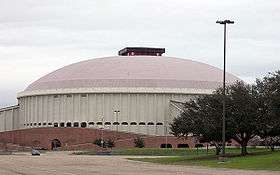
The Louisiana Ragin' Cajun teams participate in NCAA Division I (I FBS for football) in the Sun Belt Conference. The Ragin' Cajuns compete in 16 NCAA sports teams (8 men's, 8 women's teams), including baseball, basketball (men's and women's), cross country (men's and women's), football, softball, women's soccer, women's volleyball, men's golf, tennis (men's and women's), and track and field (men's and women's, indoor and outdoor).
The athletic program formally began in 1904 with a track and field program.[70] In recent years, the softball team has been among the most successful of all Ragin' Cajun teams, having won nine regular season championships, nine conference tournament championships, and earning five appearances in the Women's College World Series. The baseball, men's tennis, men's basketball, and football teams have won conference championships.
In 2014, the Cajuns became the first in college football bowl history to win the same bowl game in four straight seasons.[71] However, the university vacated all of its 2011 wins, including the New Orleans Bowl, two years later when the NCAA sanctioned the university because an assistant football coach conspired to "obtain fraudulent entrance exam scores" for five recruits from 2011 until 2013.[72] The university dismissed the coach in 2014 and sued the testing company in 2016 for failing to adequately supervise their staff and testing procedures. The NCAA accepted the university's self-imposed penalties including a two-year probation, a small fine, a small reduction in football scholarships, and recruiting restrictions.[73]
Notable people
The University of Louisiana at Lafayette is home to many alumni who have held posts as business leaders, government officials, military officers, Olympic and professional athletes, artists and entertainers. For example, from literature: James Lee Burke, Pulitzer nominee, best known for his Dave Robicheaux series; from entertainment Marc Breaux, choreographer of movies such as Mary Poppins, The Sound of Music, Chitty Chitty Bang Bang and Frank Ocean, Grammy award-winning singer, songwriter, and rapper, briefly a student after Katrina drove him out of New Orleans; from government: Kathleen Blanco, former Louisiana governor (2004–2008), John Breaux, former US senator (1987–2005), Paul Hardy, former Lieutenant Governor of Louisiana, Jefferson Caffery, former U.S. ambassador to El Salvador, Colombia, Cuba, Brazil, France, and Egypt. Patrick T. Caffery, former United States Representative (LA 3rd District 1969-1973)
Saad Khan from Mumbai, India, is a film director, screenwriter, acting teacher, founder and creative head of Centerstage. He was selected as one of the outstanding alumni of 2015 of the Department of Communication.
Two military alumni Charles B. DeBellevue and Jefferson J. DeBlanc were recognized as flying aces; DeBlanc also was awarded the Medal of Honor. Captain Steven L. Bennett was posthumously awarded the Medal of Honor in 1974. Ace Charles B. DeBellevue and Medal of Honor recipient Steven L. Bennett were members of the ROTC program and both entered active duty with the Air Force after graduating in 1968.
Distinguished faculty members have included John Kennedy Toole, Pulitzer Prize-winning author of A Confederacy of Dunces, and Ernest J. Gaines, nominated for a Nobel Prize in Literature and a Pulitzer Prize for fiction, Paul Prudhomme, American celebrity chef, Elemore Morgan, Jr., internationally known landscape painter, and Burton Raffel, poet noted for his translation of Cervantes's Don Quixote.
Several football alumni have played in the National Football League, including Jake Delhomme (retired), Brian Mitchell (retired), Brandon Stokley (retired), the late Minnesota Viking Orlando Thomas, Ike Taylor (retired), Charles Tillman (retired) and Richie Cunningham (retired). Two alumni were inducted to the College Football Hall of Fame: Chris Cagle and Weldon Humble.
Baseball alumni who played in the Major Leagues include Ron Guidry, retired (New York Yankees), who won the 1978 American League Cy Young Award.
Basketball alumni who played in the National Basketball Association include Elfrid Payton.
Kim Perrot played for the Houston Comets, helping them to win two WNBA championships. Other alumni include Olympic track & field medalist Hollis Conway and world-title trampolinist Leigh Hennessy, who holds the record for winning the most US national championships for women.
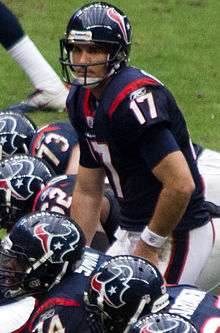 Jake Delhomme, NFL quarterback who led the Carolina Panthers to their first NFC conference championship.
Jake Delhomme, NFL quarterback who led the Carolina Panthers to their first NFC conference championship. Ali Landry, former Miss USA (1996), model and actress.
Ali Landry, former Miss USA (1996), model and actress.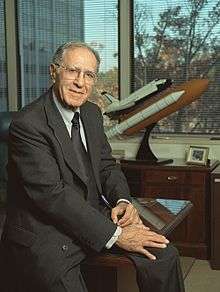 Alex McCool, manager of the Space Shuttle Projects Office at the NASA George C. Marshall Space Flight Center.
Alex McCool, manager of the Space Shuttle Projects Office at the NASA George C. Marshall Space Flight Center..jpg) Frank Ocean, Grammy award-winning artist, singer, songwriter, and rapper.
Frank Ocean, Grammy award-winning artist, singer, songwriter, and rapper.
References
- "The University (history)". December 19, 2012.
- "University of Louisiana at Lafayette Foundation, Inc. Financial Report June 30, 2018" (PDF). p. 19. Retrieved October 19, 2019.
- "Preliminary Headcount Enrollment Summary". Louisiana Board of Regents. September 2016. Retrieved October 19, 2016.
- "University of Louisiana at Lafayette Brand Guide and Graphic Standards Manual" (PDF). Retrieved June 15, 2016.
- "Archived copy". Archived from the original on June 10, 2008. Retrieved October 21, 2008.CS1 maint: archived copy as title (link)
- "Academics 1902-03". RaginPagin.com. Retrieved January 1, 2015.
- "Name Changes & Presidents". UL Lafayette Institutional Research. Archived from the original on January 27, 2013. Retrieved September 14, 2012.
- Hurt, Cecil (September 24, 1984). "Tide foe has an identity crisis". Tuscaloosa News. Retrieved June 25, 2012.
- www.louisiana.edu "For a while in the 1980s, UL Lafayette literally made a name for itself, The University of Louisiana. A subsequent act of the Louisiana Legislature nullified that name change, but Authment persisted."
- www.athleticnetwork.net"The university flirted briefly in 1984 with the idea of yet another name change. The Board of Trustees declared the school to be the University of Louisiana, but the Board of Regents soon reversed the move. It would be more than a decade before the name stuck."
- "Archived copy". Archived from the original on January 11, 2010. Retrieved March 18, 2010.CS1 maint: archived copy as title (link)
- University History: General Archived June 10, 2008, at the Wayback Machine
- Proper use of the University's Name by UL Lafayette webpage Archived August 31, 2006, at the Wayback Machine
- https://www.citypopulation.de/php/usa-combmetro.php?cityid=318
- https://www.thevermilion.com/news/giant-fleur-de-lis-sculpture-installed-in-quad-fountain/article_b0e247d4-da12-5c02-876e-3711c9d88934.html
- https://bulliardconstruction.com/portfolio/ul-cypress-lake-plaza/
- https://studentunion.louisiana.edu/looking-forward
- https://www.theadvocate.com/acadiana/news/education/article_82b2ea5b-334e-5493-ba8f-2eec5c4d9045.html
- https://president.louisiana.edu/strategies-plans/master-plan
- https://facilities.louisiana.edu/about-us/campus-info
- https://ragincajuns.com/facilities
- https://recsports.louisiana.edu/
- https://louisiana.edu/news-events/news/20160316/intramurals-sports-complex-building-construction-progressing
- https://www.louisiana.edu/research/research-park/research-park-tenants
- https://louisiana.edu/news-events/news/20180522/tech-company-cgis-expansion-lafayette-bring-400-new-jobs
- https://louisiana.edu/sites/louisiana/files/DesignVision_ULMPrevised9.3.14-small.pdf
- https://louisiana.edu/news-events/news/20180503/construction-expand-university-housing-add-retail-space-campus
- https://housing.louisiana.edu/future-residents/residence-halls/traditional-female-only
- https://president.louisiana.edu/sites/louisiana/files/AAA-MasterPlan.pdf
- "UL Lafayette: Public Relations: News Release: 2004: #259". Retrieved January 1, 2015.
- "ACM Student Chapter Manual: Part 2". Archived from the original on January 1, 2015. Retrieved January 1, 2015.
- "CACS Website Redirect". Archived from the original on August 1, 2016. Retrieved June 15, 2016.
- "CODOFIL - Council for the Development of French in Louisiana". Retrieved June 15, 2016.
- CAPE-1 Launch in chronology to others Archived January 18, 2010, at the Wayback Machine
- "Newsmaker of the Year". theind.com. Retrieved June 23, 2013.
- "History of Informatics Research Institute". louisiana.edu. Retrieved May 30, 2017.
- "UL Lafayette launches state's first informatics master's degree". louisiana.edu. Retrieved May 30, 2017.
- "Page not found". Carnegie Foundation for the Advancement of Teaching. Retrieved January 1, 2015.
- https://louisiana.edu/news-events/news/20180815/research-and-development-expenditures-top-100-million
- UL Lafayette Among Top 100 Public Research Universities in the Nation - March 24, 2010 Archived July 26, 2011, at the Wayback Machine
- "Archived copy". Archived from the original on February 10, 2012. Retrieved February 14, 2012.CS1 maint: archived copy as title (link) University of Louisiana at Lafayette and Drexel University Establish National Science Foundation Industry/University Cooperative Research Center - February 8, 2012
- "CVDI solidifies lead in big data with additional NSF funding". University of Louisiana at Lafayette. March 29, 2017. Retrieved October 23, 2017.
- "Availability of Species". New Iberia Research Center. University of Louisiana at Lafayette. Retrieved July 14, 2015.
- "History". New Iberia Research Center. University of Louisiana at Lafayette. Retrieved July 14, 2015.
- "University of Louisiana at Lafayette Annual Report". Animal Care Information System Search Tool. U.S. Department of Agriculture. Archived from the original on July 15, 2015. Retrieved July 14, 2015.
- "Animal Procurement". New Iberia Research Center. University of Louisiana at Lafayette. Retrieved July 14, 2015.
- Fletcher, Lisa; Ghadishah, Arash (March 4, 2015). "Exclusive: Ex-Employees Claim 'Horrific' Treatment of Primates at Lab". ABC News. Retrieved July 14, 2015.
- Burgess, Richard (April 21, 2015). "USDA files complaint over primate treatment at New Iberia facility". The Advocate. Retrieved July 14, 2015.
- "Retired Chimps".
- "Southern Association of Colleges and Schools - Southern Association of Colleges and Schools". Retrieved January 1, 2015.
- "University Honors Program". Retrieved January 1, 2015.
- "America's Top Colleges 2019". Forbes. Retrieved August 15, 2019.
- "U.S. College Rankings 2020". Wall Street Journal/Times Higher Education. Retrieved September 26, 2019.
- "Best Colleges 2020: National University Rankings". U.S. News & World Report. Retrieved September 8, 2019.
- "2019 National University Rankings". Washington Monthly. Retrieved August 20, 2019.
- "Best Global Universities Rankings: 2020". U.S. News & World Report LP. Retrieved October 22, 2019.
- https://www.louisiana.edu/news-events/news/20180125/us-news-world-report-students-are-%E2%80%98eager%E2%80%99-attend-ul-lafayette. Retrieved January 25, 2018. Missing or empty
|title=(help) - "Ladders, labs, or laggards? Which public universities contribute most". July 11, 2017. Retrieved January 25, 2018.
- https://www.louisiana.edu/news-events/news/20170901/petroleum-engineering-department-earns-international-recognition. Retrieved January 25, 2018. Missing or empty
|title=(help) - "BestBusiness Business Schools 2018 | Business School Rankings | The Princeton Review". Retrieved January 25, 2018.
- "Best 382 Colleges 2018". The Princeton Review. Retrieved January 25, 2018.
- "2014 President's Higher Education Community Service Honor Roll". Archived from the original on December 30, 2014. Retrieved January 1, 2015.
- "Research funding in NSF top 10 for business share". September 30, 2013. Retrieved June 15, 2016.
- "2016 Green Ribbon Schools". U.S. Department of Education. Retrieved September 19, 2016.
- "Center for Louisiana Studies". Retrieved January 1, 2015.
- "Fine art of printmaking humming along at University's Marais Press". louisiana.edu. August 9, 2013.
- Elemore Morgan Jr
- "Brian Kelly, Professor". louisiana.edu. December 10, 2015.
- "Alphabetical List of UL Lafayette Student Organizations". louisiana.edu. Retrieved May 30, 2017.
- "Overall Introduction - Louisiana's Ragin Cajuns Athletic Network". Retrieved January 1, 2015.
- "Ragin Cajuns Athletics - Total Effort Helps Cajuns Stuff Nevada In R+L Carriers New Orleans Bowl". Ragin' Cajuns Athletics. Retrieved January 1, 2015.
- NCAA (January 12, 2016). "University of Louisiana at Lafayette Public Infractions Decision" (PDF). Retrieved January 13, 2016.
- Doug Lederman (January 13, 2016). "NCAA punishes Louisiana-Lafayette over test fraud, and university sues ACT". Inside Higher Ed. Retrieved January 13, 2016.
External links
| Wikimedia Commons has media related to University of Louisiana at Lafayette. |